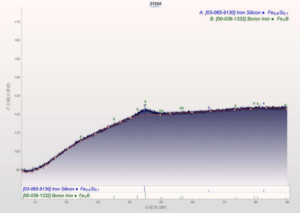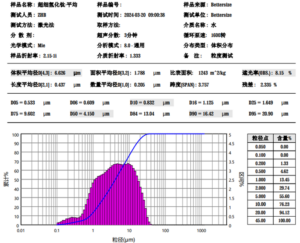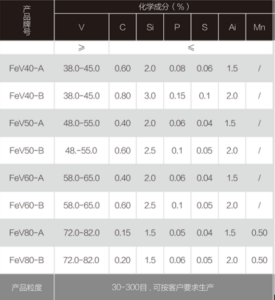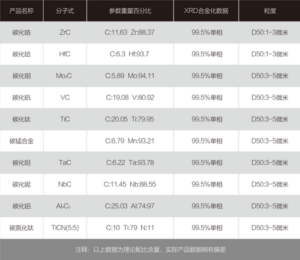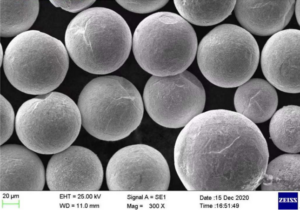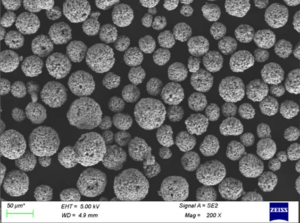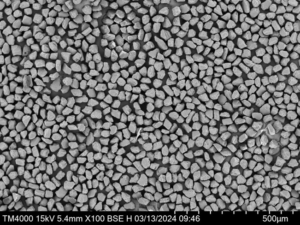Tabla de contenidos
ToggleIn the realm of metal additive manufacturing, the choice of powder is akin to picking a champion for your team. Each contender brings unique strengths and weaknesses to the table, and selecting the right one hinges on the specific needs of your project. Today, we enter the arena to witness the clash of the titans: low alloy steel powder versus a squadron of its metallic adversaries.
We’ll delve into the properties, applications, and battle cries (advantages and disadvantages) of each powder type, equipping you to make a strategic selection for your next 3D printing conquest.
Low Alloy Steel Powder: The Workhorse Warrior
Low alloy steel powder (LASP) is a formidable force in the metal additive manufacturing arena. Think of it as the dependable knight in shining armor, offering a compelling blend of strength, affordability, and versatility. But like any warrior, it has its limitations.
Composition and Characteristics:
LASP is an iron-based powder alloyed with small amounts of elements like manganese, chromium, nickel, and molybdenum. These alloying elements, though minimal, significantly enhance its mechanical properties compared to pure iron powder.
Properties:
- High Strength and Hardness: LASP boasts superior strength and hardness compared to many other metal powders. This makes it an ideal choice for components that need to withstand significant loads and forces, such as gears, sprockets, and tools.
- Good Toughness and Plasticity: While not the most flexible contender, LASP offers a respectable balance between strength and some degree of bendability. This allows parts to absorb some impact without succumbing to brittle fracture.
- Decent Wear and Corrosion Resistance: The presence of alloying elements like chromium can enhance LASP’s resistance to wear and tear, making it suitable for applications exposed to friction and harsh environments.
- Affordable: Compared to some exotic metal powders, LASP is a relatively cost-effective option. This opens doors for projects where budget is a key consideration.
- Wide Range of Printability: LASP exhibits good flowability and laser compatibility, making it suitable for various additive manufacturing techniques like Laser Powder Bed Fusion (LPBF).
Applications:
LASP finds application in a diverse range of industries, including:
- Automotive: Gears, sprockets, engine components
- Aerospace: Brackets, structural elements
- Industrial Machinery: Tools, dies, jigs, fixtures
- Consumer Goods: Sporting equipment, hardware
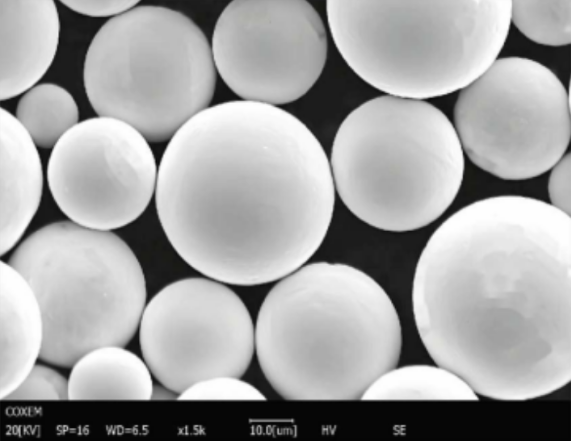
Specifications, Sizes, Grades, and Standards:
LASP comes in a variety of specifications, sizes, and grades depending on the manufacturer and desired properties. Common standards include ASTM International (ASTM) and the Metal Powder Industries Federation (MPIF). Here’s a glimpse into the variations:
| Parameter | Description |
|---|---|
| Size | Typically ranges from 15 to 150 microns |
| Grade | Can vary based on specific alloying elements and their percentages |
| Standards | Common standards include ASTM A29, ASTM B294, MPIF 05 |
Pros and Cons of Low Alloy Steel Powder
| Advantage | Disadvantage |
|---|---|
| High strength and hardness | Lower ductility compared to some other metal powders |
| Good toughness and plasticity | Can be susceptible to rust and corrosion in extreme environments |
| Affordable | May require post-processing for optimal surface finish |
| Wide range of printability | Not ideal for applications requiring high corrosion resistance |
The Metal Powder Posse: A League of Extraordinary Materials
While LASP reigns supreme in many applications, other metal powders offer distinct advantages for specific needs. Let’s introduce some of the key contenders in the metal powder arena:
1. Stainless Steel Powders (316L, 17-4 PH): These warriors shine in their resistance to corrosion and high temperatures. Imagine them as the stoic guardians, ideal for applications in harsh environments like marine components or medical implants.
2. Tool Steel Powders (M2 High Speed Steel, H13 Tool Steel): Think of these as the berserkers of the group. Tool steel powders boast exceptional hardness and wear resistance, making them perfect for cutting tools, dies, and molds that need to withstand extreme wear and tear.
3. Aluminum Powders (AlSi10Mg, AlSi7Mg): These lightweight champions prioritize agility and speed. Aluminum powders offer excellent strength-to-weight ratios and good corrosion resistance, making them ideal for applications in aerospace and automotive
4. Nickel-based Powders (Inconel 625, Inconel 718): Imagine these as the heat-resistant alchemists. Nickel-based powders excel in high-temperature environments due to their exceptional resistance to oxidation and creep. They find application in jet engines, gas turbines, and other components exposed to extreme heat.
5. Titanium Powders (CP Ti, Ti-6Al-4V): These are the noble warriors, offering a unique blend of strength, low weight, and excellent biocompatibility. Titanium powders are particularly valuable for aerospace components and medical implants due to their weight savings and compatibility with the human body.
6. Copper Powders: Think of these as the electricity conductors of the group. Copper powders boast exceptional thermal and electrical conductivity, making them ideal for applications in heat sinks, electrical components, and electromagnetic shielding.
7. Cobalt Chrome Powders (CoCrMo): Imagine them as the champions of wear resistance. Often used in the medical field for implants like artificial joints, cobalt chrome powders offer exceptional wear resistance and biocompatibility.
8. Tungsten Powders: These heavy hitters pack a punch in terms of density. Tungsten powders are incredibly dense and offer superior properties for radiation shielding and armor applications.
9. Precious Metal Powders (Gold, Silver, Platinum): These are the elite guard, valued for their unique properties and aesthetics. Precious metal powders find application in jewelry, electronics, and even some medical devices due to their conductivity, corrosion resistance, and biocompatibility.
10. Refractory Metal Powders (Tantalum, Molybdenum): Imagine these as the heat shields of the group. Refractory metal powders boast incredibly high melting points, making them ideal for applications in furnaces, crucibles, and other high-temperature environments.
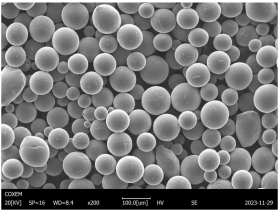
A Tale of Two Titans: A Side-by-Side Comparison
Now that we’ve assembled our metal powder legion, let’s delve deeper into a head-to-head comparison between LASP and some of its prominent rivals:
| Metric | Low Alloy Steel Powder | Stainless Steel Powders (316L) | Tool Steel Powders (M2) | Aluminum Powders (AlSi10Mg) |
|---|---|---|---|---|
| Strength | High | High | Very High | Moderate |
| Hardness | High | Moderate | Very High | Moderate |
| Toughness | Moderate | Moderate | Low | High |
| Ductility | Moderate | Low | Low | High |
| Wear Resistance | Good | Moderate | Very High | Moderate |
| Corrosion Resistance | Moderate | High | Low | High |
| Weight | Heavy | Moderate | Heavy | Light |
| Printability | Good | Good | Moderate | Good |
| Cost | Affordable | Moderate | High | Moderate |
| Metric | Nickel-based Powders (Inconel 625) | Titanium Powders (CP Ti) | Copper Powders | Cobalt Chrome Powders (CoCrMo) | Tungsten Powders |
|---|---|---|---|---|---|
| Strength | High | High | Low | High | Very High |
| Hardness | Moderate | Moderate | Low | High | Very High |
| Toughness | Moderate | High | Low | Moderate | Low |
| Ductility | Moderate | High | High | Low | Low |
| Wear Resistance | Good | Moderate | Low | Very High | High |
| Corrosion Resistance | High | Moderate | Low | Moderate | Low |
| Weight | Heavy | Moderate | Light | Heavy | Very Heavy |
| Printability | Moderate | Moderate | Good | Moderate | Moderate |
| Cost | High | High | Moderate | High | Very High |
Matching Needs with Material
As with any good battle royale, selecting the victor depends on the specific needs of your project. Here are some key considerations to guide your choice:
- Required Strength and Hardness: For applications demanding high load-bearing capacity and resistance to deformation, LASP, tool steel powders, or nickel-based powders might be ideal choices.
- Ductility and Toughness: If your project requires some degree of bendability and impact resistance, aluminum powders or titanium powders could be better suited.
- Wear Resistance: Components exposed to significant friction and wear benefit from tool steel powders, cobalt chrome powders, or tungsten powders.
- Corrosion Resistance: For environments prone to rust or harsh chemicals, stainless steel powders or nickel-based powders offer superior protection.
- Weight Considerations: When weight reduction is a priority, aluminum powders or titanium powders become strong contenders.
- Printability: LASP and aluminum powders generally exhibit good printability across various additive manufacturing techniques. However, some metal powders, like tool steels and nickel-based alloys, can be more challenging to print due to their higher melting points and flowability characteristics. Consider consulting with a metal additive manufacturing expert to determine the most suitable powder for your chosen printing technology.
- Cost: LASP is a budget-friendly option compared to many exotic metal powders like titanium or precious metals. However, factor in the potential costs of post-processing for LASP if a high-quality surface finish is required.
Beyond the Battlefield: Considerations for Success
While material selection is a crucial step, it’s just one piece of the puzzle. Here are some additional factors to consider for a successful metal additive manufacturing project:
- Part Design: Designing your part specifically for additive manufacturing can unlock the full potential of the technology. This might involve incorporating internal lattice structures for weight reduction or designing features that are difficult or impossible to achieve with traditional manufacturing techniques.
- Process Parameters: Optimizing the laser power, scan speed, and other process parameters for your chosen metal powder is essential for achieving the desired mechanical properties and surface finish of your printed part. Collaboration with an experienced AM service provider can be invaluable in this stage.
- Post-Processing: Depending on the metal powder and application, post-processing techniques like heat treatment, hot isostatic pressing (HIP), or machining might be necessary to achieve the final desired properties and dimensional accuracy.

FAQ
Q: What is the difference between metal powder and metal filament used in 3D printing?
A: Metal powders are primarily used in powder bed fusion (PBF) additive manufacturing techniques, where a laser beam selectively melts the powder particles layer by layer to build the desired 3D object. Metal filaments, on the other hand, are used in Fused Deposition Modeling (FDM) for metals, where a metal-filled wire is fed through a heated nozzle and deposited layer-by-layer to create the object. Metal FDM is a relatively new technology with limitations compared to PBF, but it offers potential advantages like wider material compatibility and lower cost.
Q: How safe is it to handle metal powders?
A: Metal powders can pose health risks if inhaled, so proper safety precautions are crucial. This includes using a ventilated enclosure during printing, wearing appropriate personal protective equipment (PPE) like gloves and respirators, and following safe handling practices as recommended by the powder manufacturer.
Q: What are the future trends in metal powder technology?
A: The metal powder landscape is continuously evolving. We can expect advancements in areas like:
- Development of new metal powder alloys with improved properties like higher strength-to-weight ratios or enhanced corrosion resistance.
- Advancements in powder manufacturing techniques to produce finer and more uniform powder particles, leading to improved printability and surface finish.
- Increased focus on sustainability, with the development of recycled metal powders or powders with lower environmental impact.
The Final Verdict: A Symphony of Strengths
The choice of metal powder isn’t a duel, but rather an orchestra of possibilities. Each metal powder brings a unique set of strengths to the table, and the optimal selection hinges on the specific requirements of your project. By understanding the properties, applications, and limitations of various metal powders, you can make an informed decision and unlock the true potential of metal additive manufacturing.
